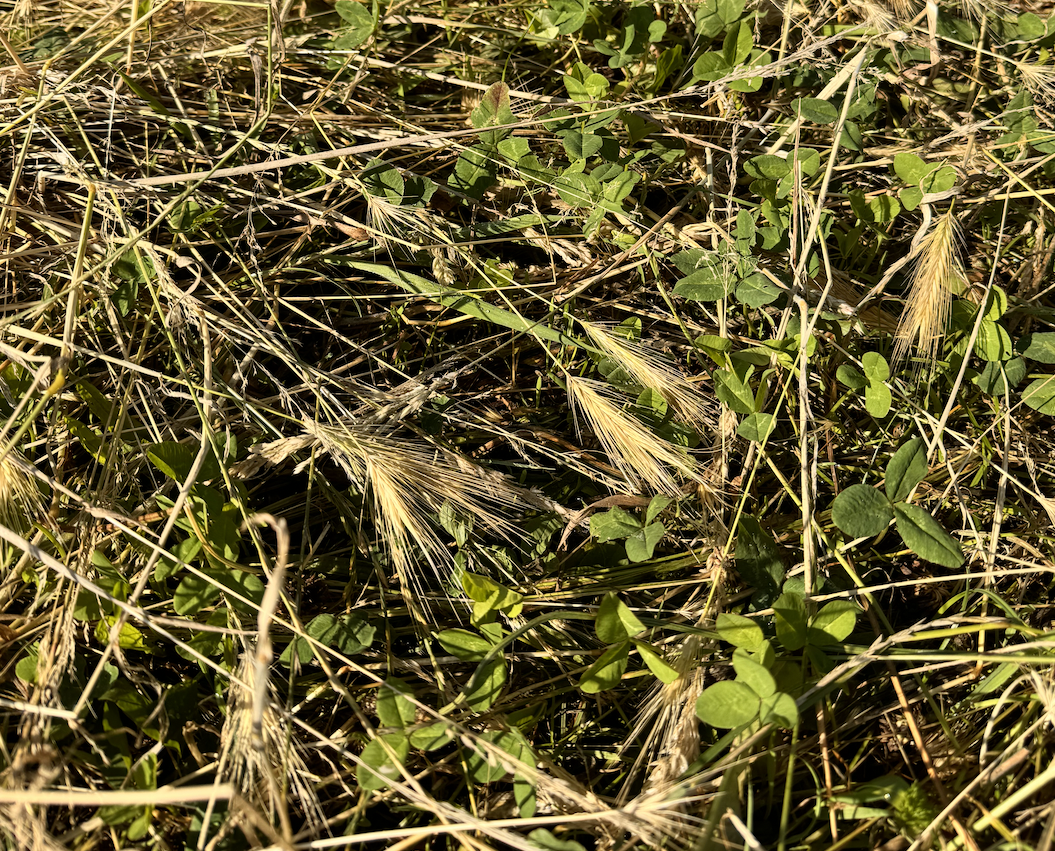As a doodle mom, you treasure the outdoor adventures and those hilarious moments of frolicking with your fluffy companion. But lurking in those grassy fields are sneaky little villains known as foxtails, ready to turn your doodle’s day into a not-so-funny horror story. Let’s dive into the wild world of foxtails, why they’re a menace, and how to keep your doodle safe and sound.
Are you a Doodle Mom?
Join a pawsome community of doodle moms, and discover more tail-wagging tips.
Join the Doodle Moms Club →What the Heck Are Foxtails?
Foxtails are the dried seed heads of certain grasses, often found in dry, grassy areas during late spring and summer. Picture tiny, barbed missiles just waiting to hitch a ride on your doodle. These crafty seeds are designed to burrow into the soil, but they have a nasty habit of embedding themselves in your doodle's skin, ears, nose, eyes, and paws. Once in, they only move forward, like the world's tiniest, spikiest army.
The Risks of Foxtails (a.k.a. Doodle's Worst Nightmare)
Ouch! Physical Injuries
Foxtails are like nature's own little ninja stars. They can cause painful abscesses and infections when they pierce your doodle’s skin. These sharp awns can puncture delicate tissues, leading to major discomfort and making your doodle look like it just went three rounds with a prickly pear.
The Great Migration (Internal Style)
Foxtails don’t just stop at the skin; they’re like the Indiana Jones of the seed world. If inhaled or ingested, they can journey through your doodle’s respiratory or digestive system, causing internal chaos. This migration can lead to serious, life-threatening conditions requiring urgent veterinary heroics.
Infection Invasion
These pesky foxtails come armed with bacteria, ready to set up camp and cause infections. Once they dig in, infections can be tough to treat, especially if the foxtail has gone deep. Look out for swelling, redness, discharge, and your doodle obsessively licking or scratching like it’s auditioning for a doggie drama.
Sniff out the latest scoop!
Sign up for the Doodleez mailing list for tail-wagging news!
Join Doodleez Mailing ListEye and Ear Catastrophes
If a foxtail lodges in your doodle’s eyes or ears, it’s a recipe for disaster. In the eyes, foxtails can cause corneal ulcers or conjunctivitis, which sounds like a fancy word but is actually quite painful. In the ears, foxtails can cause intense pain, infections, and even hearing loss, leaving your doodle looking and feeling miserable.
Dodging the Foxtail Bullet
Avoiding Foxtail Hotspots
First rule of foxtail fight club: avoid dry, grassy fields during foxtail season. Opt for well-maintained parks or trails where foxtails are less likely to ruin your doodle’s day.
Groom Like a Pro
Regular grooming is key to preventing foxtail fiascos. Keep your doodle’s coat trimmed, especially around the paws, ears, and face. Brush your doodle thoroughly after outdoor escapades to remove any hitchhiking foxtails.
Suit Up!
Consider using protective gear like booties, vests, or even doggy goggles for your doodle during outdoor adventures. These stylish accessories not only look adorable but can also keep foxtails at bay.
Inspect Like a Detective
After each walk or outdoor romp, give your doodle a thorough once-over. Pay extra attention to the paws, between the toes, under the armpits, inside the ears, and around the eyes and mouth. Catching foxtails early can prevent them from causing serious trouble.
Vet to the Rescue
If you suspect a foxtail encounter, don’t play detective for too long. Seek veterinary help immediately. Early intervention can prevent complications and ensure those nasty foxtails are safely removed. Watch for signs like excessive licking, head shaking, pawing at the face, sneezing, or mysterious swelling.
Wrapping Up
Foxtails might seem like harmless little plants, but they’re the arch-nemesis of every doodle. By avoiding high-risk areas, grooming regularly, using protective gear, and conducting thorough inspections, you can keep your doodle safe from these sneaky seed heads. Stay vigilant, and consult your vet at the first sign of foxtail trouble to ensure your doodle’s health and happiness.
Remember, a happy doodle is a foxtail-free doodle!



